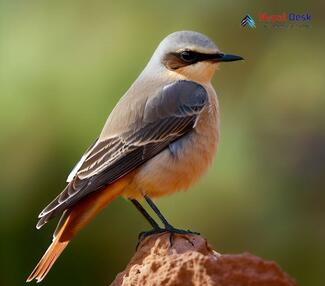The world of birds is vast and diverse, with each species having its own unique characteristics. Today, we're diving into the intriguing world of the Red-tailed Wheatear (Oenanthe chrysopygia), a bird native to parts of Asia and the Middle East. In this article, we'll explore their taxonomy, physical features, preferred habitats, diet, presence in Nepal, and an interesting aspect that sets them apart.
Taxonomy and Physical Features
Belonging to the family Muscicapidae, the Red-tailed Wheatear has a scientific name of Oenanthe chrysopygia. This small passerine bird measures approximately 14-16 cm in length and weighs around 22-36 grams. The most striking feature of the Red-tailed Wheatear is its vivid red tail feathers, which contrast with the dull grey upperparts and lighter underparts. Adult males have more bold markings than females, making them easier to identify.
Habitat and Range
Red-tailed Wheatears are found across various ecological regions, ranging from semi-deserts and desert steppes to high mountain plateaus. Their preferred habitats consist of areas with loose soil or sand on which they can build their nests. Countries where these birds can be found include Iran, Afghanistan, Pakistan, India, Nepal, and some regions in Central Asia.
Dietary Preferences
These ground-dwelling birds primarily feed on insects such as ants, beetles, grasshoppers, and termites. Occasionally, they will also consume seeds and berries if their typical food sources are scarce. The Red-tailed Wheatear’s diet helps control insect populations in their habitat while also providing essential nourishment for survival.
Presence in Nepal
In Nepal, the Red-tailed Wheatear can be spotted in Sagarmatha National Park, which is best known for Mount Everest. Their population is concentrated primarily in the alpine regions of the park, where they can be sighted perched on boulders or foraging for insects on the ground.
An Interesting Point: Vocalizations
The most intriguing aspect of the Red-tailed Wheatear is its ability to produce a wide array of vocalizations. With sharp, high-pitched calls and beautiful songs, their complex repertoire serves to attract mates and defend territories. Both males and females are known to sing, making them an auditory delight in their native environment.
In conclusion, the Red-tailed Wheatear is a captivating bird with distinct physical attributes and behaviors that set it apart from other species. Whether you encounter them in Nepal's Sagarmatha National Park or simply learn about them from a distance, these birds are sure to leave an impression on bird enthusiasts and casual observers alike.




